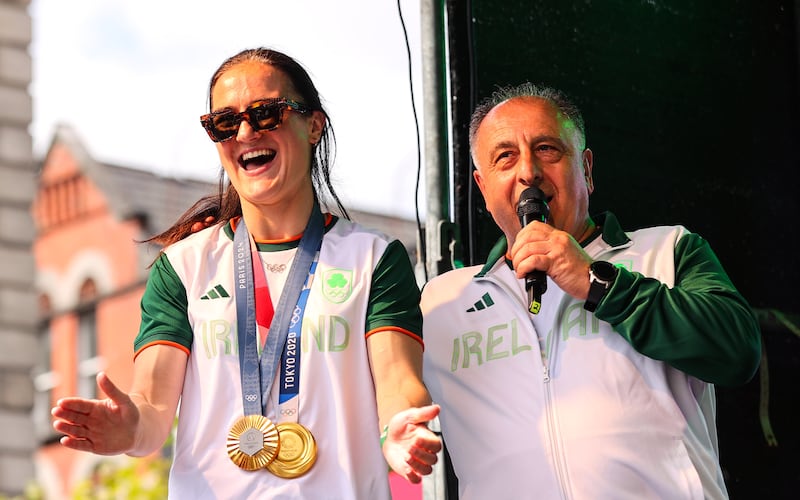Half a billion euro is a lot of money, even in the post-medal glow of Ireland’s most successful Olympics.
With both sports minister Thomas Byrne and Tánaiste Micheál Martin promising bigger than ever funding in sport, it’s worth asking just who’s getting what – and when?
By far the biggest chunk – €250 million – consists of grants given out under the Sports Capital and Equipment Programme, for applicants that range from soccer, rugby and GAA clubs to schools, universities, residents’ associations and scout troops, to name just a few.
Then there’s €120 million being made available under what’s known as the Large-Scale Sports Infrastructure Fund, through which local authorities or sports governing bodies can apply for funding of between €500,000 and €30 million on sports stadiums, swimming pools, athletics tracks and the likes.
READ MORE
Other major capital funding will include the national velodrome and badminton centre at the National Sports Campus at Blanchardstown, which has just gone to tender, and could cost north of €60 million.
All of that will, in large part, be funded by the Department of Sport from its ever-expanding budget.
But in truth, this week what people are really wondering is how much more will our Olympians, the source of so much pride and enjoyment over the last few weeks, be getting over the next four years?
Our high-performance athletes – that is to say, the pool of non-professional or semi-professional athletes from whom our Olympics teams are drawn – are funded out of the current spending (as distinct from the big capital spending outlined above) provided by the Department of Sport.

The department gives Sport Ireland a budget, which it increased to €106.7 million last year, which Sport Ireland in turn uses to partly fund high-performance sport in Ireland.
The funding for 2023 gives an insight into how it breaks down. First, there is the funding through the high-performance programme, which in 2023 was €10.8 million. This is distributed to different sporting bodies so they can support their high-performance athletes,. There was a further €3.8 million for the international carding scheme, through which athletes are funded to compete at international level.
But it doesn’t end there. In 2023 Sport Ireland also gave another €2.7 million in “impact funding” for Paris 2024; nearly a million euro for high-performance coaching; and a million more in funding for the Olympic Federation of Ireland and Paralympics Ireland.
That all came to €24.4 million, and according to the Department of Sport the figure for 2024 was more than €25 million, the highest it’s been.
That direct funding of Olympic athletes and the various support structures has been rising over the last few years. In 2019, for example, total funding was €15.9 million, which rose to €16.7 million in 2020 and to €18.2 million in 2022.
How comparable are these figures to each other? Well, not very on a year-on-year basis. The first year of an Olympic cycle is not going to be as costly as the third or fourth year, logically.
Then there’s the effect of Covid on the Tokyo games, the nature of which makes it hard to compare like with like.
Nevertheless, even allowing for those differences, the figures are clearly growing as Ireland’s Olympic ambitions do.
It’s more instructive, perhaps, to look at it in four-year cycles. During the four-year cycle leading up to the Tokyo Olympics, Sport Ireland spent €59 million, while the total amount spent on the Paris cycle was €89 million.

That figure is expected to rise before the Los Angeles games in 2028, if Mr Byrne’s public pronouncements are anything to go by.
On a number of occasions this week he has outlined an ambition to raise that annual spending to about €30 million a year – which presumes a total budget for the four-year cycle of €120 million, or twice the full budget for the Tokyo Olympics.
That’s likely to follow the same pattern, with the first two years being cheaper than the last two years, meaning the high-performance budget could be in or around €25 million in 2025 and 2026, rising to more than €35 million a year in 2027 and 2028.
Ireland’s Olympians, and aspiring Olympians, shouldn’t start counting their funding just yet. The Irish Times contacted the department to ask for precise figures, but it seems that’s still being hashed out between Government departments in the lead-up to the impending budget.
In a statement, a department spokesperson said that it wanted to see the investment in high-performance sport “grow as much as possible”, and certainly more than inflation in recent years, as much as “several million”.
But when it came to precise figures, the spokesperson noted that “all of this will of course be subject to future budget negotiations”.
Which means that Sport Ireland, the national governing bodies, the athletes, and the fans will all be hoping that the medal glow hasn’t worn off by the time those negotiations have concluded.













